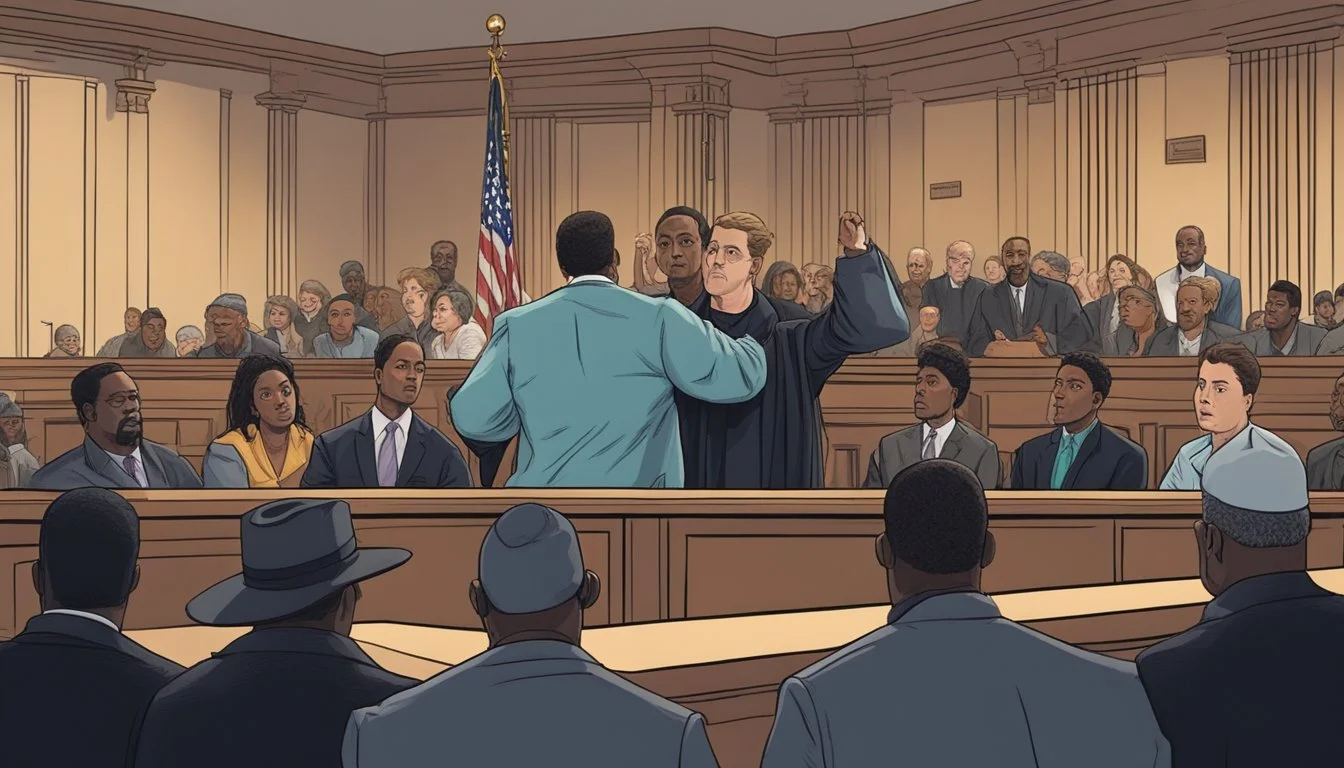Shelly Andre Brooks' Detroit Demise: Motor City Murderer's Life Sentence Ends Brutal Killing Spree
Shelly Andre Brooks terrorized Detroit in the early 2000s, leaving a trail of victims in his wake. Born on January 22, 1969, Brooks grew up to become one of the city's most notorious criminals. His reign of terror lasted from 2001 to 2006, during which he murdered at least seven women, though he was suspected of up to 20 killings.
Brooks' brutal crimes shocked the community and ultimately led to his downfall when a survivor helped authorities identify him. In 2007, he faced justice in a Wayne Circuit Court, where a jury found him guilty of first-degree murder for the 2002 killing of 33-year-old Pamela Greer. This conviction carried an automatic sentence of life without the possibility of parole in Michigan.
The case of Shelly Andre Brooks serves as a grim reminder of the dangers that can lurk in urban environments. His capture and conviction brought a measure of closure to the families of his victims and helped restore a sense of safety to the streets of Detroit.
The Life of Shelly Andre Brooks
Shelly Andre Brooks was born on January 22, 1969, in Detroit, Michigan. Little is known about his early life or upbringing.
Brooks struggled with addiction and homelessness as an adult. These challenges likely contributed to his descent into criminal behavior.
Between 2001 and 2006, Brooks committed a series of brutal murders in Detroit. He targeted vulnerable women, many of whom were involved in sex work.
Brooks's crimes involved sexual assault and extreme violence. He killed at least seven women, though he is suspected of up to 20 murders.
His reign of terror came to an end in 2006 when he was arrested. A survivor of one of his attacks provided crucial information leading to his capture.
During his trials, Brooks fully admitted to his crimes. This confession shed light on the extent of his actions but offered little explanation for his motives.
The court found Brooks guilty of multiple counts of first-degree murder. He received several life sentences without the possibility of parole.
Brooks's case highlighted issues of addiction, mental illness, and violence against vulnerable populations in Detroit. It also exposed failures in protecting at-risk communities from serial predators.
Criminal Activities in Detroit
Shelly Andre Brooks terrorized Detroit with a series of brutal murders and assaults from 2001 to 2006. His crimes primarily targeted vulnerable women in the city's most impoverished areas.
Pattern of Murders and Assaults
Brooks targeted sex workers and drug addicts in Detroit's most deprived neighborhoods. He lured victims to abandoned buildings or secluded areas before attacking them.
His method of assault was consistently violent, often involving rape and strangulation. Brooks killed at least seven women, though investigators suspected he may have been responsible for up to 20 murders.
The attacks typically occurred in areas known for high crime rates and drug activity. This made it challenging for law enforcement to identify and track Brooks' movements.
Police Investigation and Challenges
Detroit police faced significant hurdles in their pursuit of Brooks. The city's overwhelmed crime lab struggled to process evidence efficiently, leading to delays in the investigation.
Rape kits from potential victims went untested for years due to backlogs. This slowed the process of linking Brooks to multiple crimes.
Witnesses were often reluctant to come forward, fearing retaliation. The transient nature of many victims' lifestyles made it difficult to establish patterns and identify missing persons.
Brooks was eventually named a person of interest after a survivor provided crucial information. The Wayne County Prosecutor's office built a strong case, leading to Brooks' arrest and conviction.
The Arrest and Trial
Shelly Andre Brooks' reign of terror ended through DNA evidence, a survivor's testimony, and diligent police work. The investigation faced challenges but ultimately led to his conviction.
Gathering DNA Evidence
Police collected DNA samples from crime scenes and victims' bodies. They compared these samples to a database of known offenders. Initially, no matches were found. Investigators expanded their search to include individuals with criminal records not in the database.
Brooks became a suspect after a surviving victim provided a description. Police obtained a DNA sample from him. It matched evidence from multiple crime scenes, linking Brooks to the murders.
Wrongful Convictions and DNA Sample
Before Brooks' arrest, two men were wrongfully convicted for murders he committed. Carl Thornton and Rondell Love served time for separate killings later attributed to Brooks. DNA evidence eventually exonerated both men.
These cases highlighted the importance of thorough DNA testing in criminal investigations. They also raised questions about the reliability of eyewitness testimony and the need for careful scrutiny of evidence.
Wayne County Prosecutor's Role
Kym Worthy, Wayne County Prosecutor, played a key role in Brooks' prosecution. Her office built a strong case using DNA evidence and survivor testimony. Worthy's team worked closely with police to ensure all evidence was properly collected and analyzed.
The prosecution presented a compelling narrative of Brooks' crimes. They detailed his pattern of targeting vulnerable women. Worthy's office sought the maximum penalty allowed by law. Their efforts resulted in multiple life sentences without the possibility of parole for Brooks.
The Systemic Breakdown
Multiple systemic failures enabled Shelly Andre Brooks to continue his killing spree for years. Untested rape kits, internal affairs issues, and limited public information hindered the investigation and prosecution of his crimes.
Untested Rape Kits
Detroit's backlog of untested rape kits played a crucial role in Brooks' ability to evade capture. Thousands of rape kits sat untested in police storage for years, potentially containing crucial DNA evidence.
This backlog delayed the identification of Brooks as a serial offender. Many of his victims were sex workers, whose cases were often given lower priority.
The untested kits represented missed opportunities to link crimes and identify patterns. Had these kits been processed promptly, investigators might have connected Brooks to multiple assaults earlier.
Internal Affairs Report
An internal affairs report revealed significant lapses in the Detroit Police Department's handling of the Brooks case. Detectives failed to follow up on key leads and witness statements.
The report highlighted a lack of communication between precincts, allowing Brooks to operate across different areas without raising suspicion. Evidence was mishandled in some instances, compromising its usefulness in court.
Disciplinary actions were recommended for several officers involved in the investigation. The report called for improved training and oversight to prevent similar failures in future cases.
Public Information and Media Impact
Limited public information about the crimes hindered community awareness and cooperation. The police department's restrictive media policy kept many details from the public.
This lack of transparency led to criticism from victims' families and advocacy groups. Some argued that earlier public warnings could have prevented additional attacks.
Media coverage of the crimes was sporadic and often lacked crucial details. This inconsistent reporting made it difficult for the public to recognize patterns or potential risks.
Improved public information strategies were later implemented to better engage the community in future investigations.
Profile of a Serial Offender
Shelly Andre Brooks exhibited patterns typical of violent serial predators. His crimes targeted vulnerable women in Detroit, revealing a disturbed psychological profile.
Victimology and Targeted Women
Brooks preyed exclusively on women, particularly those engaged in high-risk lifestyles. His victims were often sex workers or drug users in Detroit's impoverished areas. This choice of targets allowed Brooks to operate undetected for years.
He approached women on the streets, luring them to secluded locations. Brooks then brutally assaulted and murdered his victims. His method of killing varied but typically involved extreme violence.
Authorities suspect Brooks may have claimed up to 20 victims between 2001 and 2006. However, he was convicted of murdering seven women during this period.
Psychological Analysis
Brooks displayed characteristics common among serial killers. He lacked empathy and viewed his victims as objects rather than people. This dehumanization enabled his repeated acts of violence.
Experts believe childhood trauma or abuse may have contributed to Brooks' deviant behavior. However, details of his early life remain limited.
His crimes showed signs of escalation over time, with attacks becoming more frequent and brutal. This pattern is typical of serial offenders who derive a sense of power from their actions.
Brooks' willingness to admit guilt after capture was unusual for serial killers. This behavior may indicate a desire for notoriety or an attempt to exert control over the legal process.
Consequences and Sentencing
Shelly Andre Brooks faced severe legal repercussions for his heinous crimes in Detroit. His case sparked discussions about appropriate punishments for serial killers.
Life Without Parole Verdict
A Wayne County jury found Brooks guilty of first-degree murder in 2007. The conviction carried an automatic sentence of life in prison without the possibility of parole. This ensured Brooks would never walk free again.
The life sentence provided some closure to victims' families. It also removed a dangerous predator from Detroit's streets permanently.
Debate Over the Death Penalty
Brooks' case reignited debate about capital punishment in Michigan. The state abolished the death penalty in 1846, making life without parole the harshest available sentence.
Some argued Brooks' brutal crimes warranted execution. Others felt life imprisonment was sufficient punishment. Michigan's ban on capital punishment remained in place despite the controversy.
Supporters of the existing law pointed to the finality of execution and risks of wrongful convictions. Those favoring reinstatement cited deterrence and retribution for victims.
Impact on the Community
Shelly Andre Brooks' crimes devastated Detroit, leaving lasting scars on its residents and neighborhoods. His actions exposed vulnerabilities in the city's infrastructure and law enforcement systems.
The Role of Abandoned Properties
Detroit's high number of vacant buildings played a key role in Brooks' crimes. These abandoned structures provided hiding spots and dumping grounds for bodies. The city struggled to secure and monitor these properties effectively.
Police found several victims in empty houses across Detroit's east side. This highlighted the need for better management of abandoned real estate. Community groups pushed for increased demolitions and property inspections.
The case prompted discussions about urban blight and its connection to criminal activity. City officials faced pressure to address the abandoned building crisis more aggressively.
Rebuilding Trust in Law Enforcement
Brooks' long killing spree damaged public confidence in Detroit's police force. Many questioned why it took years to apprehend such a prolific murderer operating in the city.
The homicide and sex crimes units faced scrutiny over their handling of the investigation. Internal affairs conducted reviews of case management practices. New protocols were implemented for tracking potential serial cases.
Police increased outreach efforts in high-risk communities. They formed partnerships with local organizations to improve communication with vulnerable populations. Training programs on victim sensitivity were expanded for officers.
The department worked to rebuild relationships, especially in areas most impacted by Brooks' crimes. Community policing initiatives received greater emphasis and funding.
Influential Figures and Organizations
Key advocates emerged in the aftermath of Shelly Andre Brooks' crimes, pushing for justice and reform. Their efforts shed light on systemic issues and sparked important changes in how violent crimes are investigated and prosecuted.
Kym Worthy's Advocacy
Kym Worthy, Wayne County Prosecutor, played a crucial role in addressing Detroit's backlog of untested rape kits. Her team's work led to the discovery of DNA evidence linking Brooks to additional victims. Worthy's persistent advocacy brought national attention to the issue of untested rape kits.
She launched a massive initiative to process thousands of kits, resulting in numerous convictions of serial offenders. Worthy's efforts extended beyond Detroit, inspiring similar projects in other cities facing backlogs.
Her work highlighted the importance of thorough evidence processing in solving cold cases and preventing future crimes.
'I Am Evidence' and Mariska Hargitay
The documentary 'I Am Evidence' brought widespread attention to the rape kit backlog issue. Produced by actress Mariska Hargitay, the film featured Kym Worthy's work in Detroit.
Hargitay, known for her role on "Law & Order: SVU," became a passionate advocate for sexual assault survivors. She founded the Joyful Heart Foundation, which works to end the rape kit backlog nationwide.
The documentary and Hargitay's advocacy efforts raised public awareness and pressured lawmakers to allocate resources for processing rape kits. This work indirectly supported the investigation of cases like Brooks', emphasizing the broader impact of thorough evidence processing.
Legislative and Social Responses
The Shelly Andre Brooks case prompted significant changes in Detroit's approach to public safety and community engagement. Authorities implemented new policies while citizens mobilized to increase awareness and protect vulnerable populations.
Enacting New Policies
Detroit's police department overhauled its procedures for investigating serial crimes. They established a dedicated task force to handle potential serial cases, improving communication between precincts. The city council passed ordinances to address abandoned properties, a key factor in Brooks' crimes. These laws required owners to secure vacant homes or face steep fines.
Legislators also increased funding for DNA testing and victim support services. This enabled faster processing of evidence and better assistance for survivors. The police department expanded its cold case unit, assigning more homicide detectives to review unsolved murders for potential connections.
Community Involvement and Awareness
Citizens formed neighborhood watch groups focused on protecting sex workers and other at-risk individuals. These volunteers patrolled known danger areas and reported suspicious activity to police. Local non-profits organized self-defense classes and distributed personal alarms to vulnerable populations.
Community leaders partnered with law enforcement to host town halls and safety workshops. These events educated residents on recognizing predatory behavior and reporting concerns. Social service organizations expanded outreach efforts, offering resources to help individuals exit high-risk lifestyles.
Churches and civic groups organized clean-up initiatives to board up abandoned buildings. This reduced potential hiding spots for criminals and improved neighborhood safety. The city launched a public awareness campaign, using billboards and social media to encourage vigilance and reporting of unusual activity.








